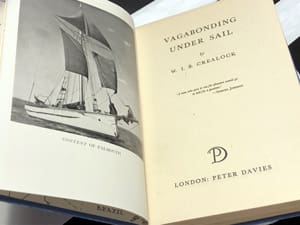While he is best remembered as the designer of a host of famous yachts including the Westsail, Pacific Seacraft, Cabo Rico, Dana 24 and Columbia, English-born W.I.B. Crealock (1920-2009) began his love affair with sailboats in 1948 when he and three friends sailed from England to British Guiana. While studying naval architecture at Glasgow University, Crealock worked at Glasgow Shipyard and designed tankers during World War II. After the war, restless and ready for adventure, he and three friends bought an old cutter named Content and “set out to study the behavior of boats at sea.” After a two-year journey, they arrived in the U.S. Crealock recounted his adventures in a book titled Vagabonding Under Sail.
Content departed the U.K., heading south to Spain, Portugal, Morocco and Tenerife, then across the Atlantic to British Guiana, St. Lucia, Jamaica and Florida, and sailing up the East Coast to end at City Island.
Content made landfall at Georgetown. Crealock explained the reason for this: “In choosing our trans-Atlantic landfall, we had simply pulled out the atlas of South America and the Caribbean. We noticed a patch of red just below the northeastern corner of South America and found it to be Britain’s only South American colony — British Guiana — as we knew nothing whatsoever about it, we decided to make Guiana our destination.”
Content was described as a Falmouth quay punt, a type of sailing craft designed to stay at sea in stormy weather. Built of pitch pine planking in 1914, Content measured 40 feet long with a beam of 11 feet and a 7.5-foot draft. Crealock rigged the ship with a square sail and rafees to facilitate downwind sailing, making the trans-Atlantic passage easier to steer.
Of course, the only means of navigation during that time was celestial. Sailors learned it and took off on great journeys, usually arriving at their destinations without too much trouble. In this instance, Crealock was the skipper of Content and not the navigator. The navigator claimed to have spent only two days studying celestial navigation, but because of his experience as a surveyor he had familiarity in handling instruments. He insisted that accuracy of position to five nautical miles was satisfactory. They would usually take a morning sight, a noon sight, an afternoon sun sight and advance their LOPs.
So let’s join the crew aboard Content approaching the coast of South America. It is April 15, and the DR position of Content is 8° 35’ N by 055° 25’ W. We are doing a lower limb noon sight to find latitude. The Hs of the observation is 88° 33’. We are using the 2019 Nautical Almanac and there is no sextant error. Height of eye is 10 feet. We are looking for time in GMT. This is a tricky problem, as the declination is greater than the latitude.
A. What is the time of LAN?
B. What is the Ho?
C. What is the latitude?
Answers
A. Time of LAN in GMT is 15:41:40
B. Ho is 88° 45.8’
C. Latitude is 8° 34.9’ N

